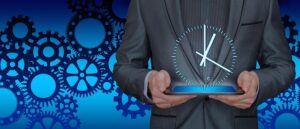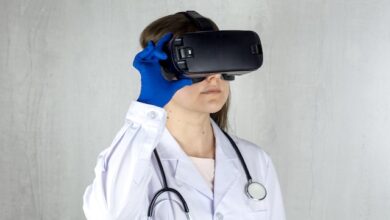The Benefits and Challenges of Using Smart Glasses in the Workplace

Introduction
Smart glasses, also known as augmented reality (AR) glasses, are wearable devices that have been available for some time now and are becoming increasingly popular in the workplace.
Further, These innovative glasses can display information in the wearer’s field of view, offering an immersive and hands-free experience. Smart glasses use AR technology to provide users with a real-time and interactive experience that can be used for various applications.
In this article, we will explore the benefits and challenges of using smart glasses in the workplace. Smart glasses can improve efficiency and productivity, enhance safety and training, and streamline communication and collaboration.
However, they also face challenges such as cost, privacy and security concerns, and user acceptance and adoption. Therefore, businesses need to carefully consider and plan for the use of smart glasses to ensure their effective and safe integration into the workplace.

Benefits of Smart Glasses in the Workplace
Hands-Free Operation
Smart glasses are wearable devices that provide a hands-free user experience, unlike traditional devices such as laptops and tablets. This is one of the primary benefits of smart glasses in the workplace.
By using smart glasses, workers can access information without having to hold or manipulate a device, freeing up their hands to perform tasks more efficiently.
Additionally, This can be particularly useful in settings such as manufacturing, where workers need to use their hands to operate machinery or perform manual tasks while also accessing information.
For example, in a warehouse setting, workers can use smart glasses to scan barcodes or access inventory information while picking and packing items, without having to put down their tools or equipment.
In a healthcare setting, doctors and nurses can use smart glasses to access patient information or take notes while performing procedures, without having to stop and manipulate a separate device.
However, the hands-free operation of smart glasses can significantly improve efficiency and productivity in the workplace by allowing workers to access information while performing tasks with their hands.

Improved Efficiency and Productivity
Smart glasses are wearable devices that can overlay digital information on the wearer’s field of view. These glasses have the potential to increase efficiency and productivity in the workplace by reducing the time and effort required to access and process information.
For example, smart glasses can provide workers with real-time information on inventory levels and delivery schedules.
Further, This allows them to make more informed decisions and reduces the time spent searching for information. By having this information readily available, workers can complete tasks more quickly and accurately, increasing efficiency.
Similarly, in the manufacturing industry, smart glasses can provide workers with real-time data on production targets and quality control measures. This information can help workers identify and address issues more quickly, reducing downtime and increasing productivity.
However, smart glasses enable workers to access important information without having to use their hands, which frees them up to perform tasks more efficiently.
Moreover, This can have a significant impact on the workplace by reducing errors, increasing productivity, and improving safety. As smart glasses become more advanced, we can expect to see even more benefits in the workplace.

Improved Training and Onboarding
Smart glasses can be used in the workplace to provide workers with on-the-job training and onboarding. With smart glasses, workers can receive step-by-step instructions on how to perform a task or use a piece of equipment.
Additionally, This is particularly useful for new employees who may be unfamiliar with the workplace and its processes. Smart glasses can help new employees learn quickly and efficiently, reducing the time and cost of traditional training methods.
For example, in a manufacturing setting, new employees can use smart glasses to receive real-time instructions on how to assemble a product or operate a piece of equipment. This can help them learn quickly and reduce the risk of errors. In a logistics setting, new employees can use smart glasses to receive real-time instructions on how to pick and pack orders or navigate the warehouse.
Moreover, By providing workers with on-the-job training and onboarding through smart glasses, companies can increase efficiency and productivity while reducing training costs.
However, smart glasses can help ensure that all employees are trained consistently and accurately, which can improve the quality of work and reduce the risk of errors or accidents.
Enhanced Safety and Training
Smart glasses can also enhance safety and training in the workplace. These are wearable devices that can overlay digital information on the wearer’s field of view.
Further, In hazardous environments such as chemical plants or construction sites, smart glasses can provide workers with real-time information on safety protocols and emergency procedures.
For example, if a worker is approaching a hazardous area, smart glasses can display a warning message or provide instructions on how to proceed safely. This can reduce the risk of accidents and injuries and increase overall workplace safety.
Additionally, Smart glasses can also be used to verify workers’ identities and grant access to secure areas. By using facial recognition technology, smart glasses can ensure that only authorized personnel have access to certain areas or equipment.
Furthermore, This can prevent unauthorized individuals from entering secure areas and potentially causing harm or theft. It can provide workers with real-time alerts and warnings.
For instance, in a manufacturing facility, smart glasses can alert workers if they are using equipment incorrectly or if there is a potential safety hazard in the area. In a warehouse, smart glasses can alert workers to potential collisions with other vehicles or obstacles.
However, the use of smart glasses in the workplace can significantly improve safety and security by providing workers with real-time information and warnings, verifying identities, and restricting access to secure areas.

Streamlined Communication and Collaboration
Smart glasses can streamline communication and collaboration in the workplace. Smart glasses enable remote workers to participate in meetings, share information, and collaborate with their colleagues in real-time, regardless of their location.
Further, This can improve efficiency and productivity by allowing workers to communicate and collaborate seamlessly without being physically present in the same location.
For example, in a manufacturing setting, remote workers can use smart glasses to connect with on-site workers and provide real-time support for troubleshooting issues. This can reduce downtime and increase efficiency.
Additionally, In a logistics setting, remote workers can use smart glasses to participate in meetings, review inventory levels, and make decisions about shipping and receiving.
Moreover, smart glasses can provide instant access to experts and resources, facilitating problem-solving and decision-making. With smart glasses, workers can quickly connect with experts in their field or access relevant information, reducing the time and effort required to complete tasks.
However, smart glasses can significantly improve communication and collaboration in the workplace by enabling remote workers to participate in meetings and collaborate with their colleagues in real-time, providing instant access to experts and resources, and facilitating problem-solving and decision-making.

Challenges of Smart Glasses in the Workplace
Cost
While there are many benefits to using smart glasses in the workplace, one of the most significant challenges is the cost associated with them. Smart glasses can be expensive, with prices ranging from a few hundred to several thousand dollars per unit, depending on the model and features.
For many businesses, especially small and medium-sized enterprises (SMEs), the cost of implementing smart glasses can be a significant investment. This cost may include not only the purchase of the devices themselves but also training for employees and the development of custom software or applications to integrate with existing workflows and systems.
In addition to the upfront cost, there may be ongoing expenses for maintenance, support, and upgrades. This can add to the overall cost of ownership and may be a barrier to adoption for some businesses. Many businesses may find that the benefits of smart glasses outweigh the initial investment.
However, it is important for businesses to carefully consider the costs and benefits before investing in smart glasses and to develop a clear plan for implementation and integration into existing workflows.

Privacy and Security Concerns
Smart glasses can raise privacy and security concerns in the workplace. Smart glasses are equipped with audio and video recording capabilities, which can potentially capture sensitive information and confidential data. This is particularly concerning in industries where privacy and security are paramount, such as healthcare and finance.
Furthermore, the use of smart glasses can also raise concerns about hacking and data breaches. Hackers may be able to gain access to the wearer’s device and potentially compromise the security of the wearer and the company they work for.
However, This could include stealing sensitive information, manipulating data, or even using the device as a gateway to access other parts of the company’s network.
Moreover, businesses must implement strict policies and protocols for the use of smart glasses in the workplace. This may include limiting the use of smart glasses to specific employees or tasks, ensuring that data is encrypted and secure, and regularly updating the device’s software and security features.
Importantly, businesses should ensure that employees are trained on the proper use of the devices and are aware of the potential risks associated with their use.

User Acceptance and Adoption
Smart glasses may face challenges in user acceptance and adoption in the workplace. Some employees may be hesitant to use the technology, especially if they are not familiar with it. This can lead to resistance and reluctance to adopt smart glasses in the workplace.
Additionally, businesses must provide adequate training and support to employees to help them understand how to use smart glasses effectively. This may include demonstrations and hands-on training, as well as ongoing support and troubleshooting assistance.
Moreover, it is important for businesses to consider the user experience when implementing smart glasses in the workplace. This includes factors such as comfort, design, and ease of use. Providing employees with comfortable and user-friendly smart glasses can help increase acceptance and adoption.
Further, user acceptance and adoption of smart glasses in the workplace will depend on the specific needs and culture of the organization.
However, By addressing these concerns and providing the necessary support and training, businesses can increase the likelihood of successful adoption and integration of smart glasses into their workflows.

Conclusion
In conclusion, smart glasses offer many benefits for the workplace, including improved efficiency and productivity, enhanced safety and training, and streamlined communication and collaboration.
While smart glasses hold potential to revolutionize the workplace, careful consideration of their implementation and management is necessary to ensure maximum benefits and minimize potential challenges.
However, the benefits and challenges of using smart glasses in the workplace must be carefully weighed before implementation.



